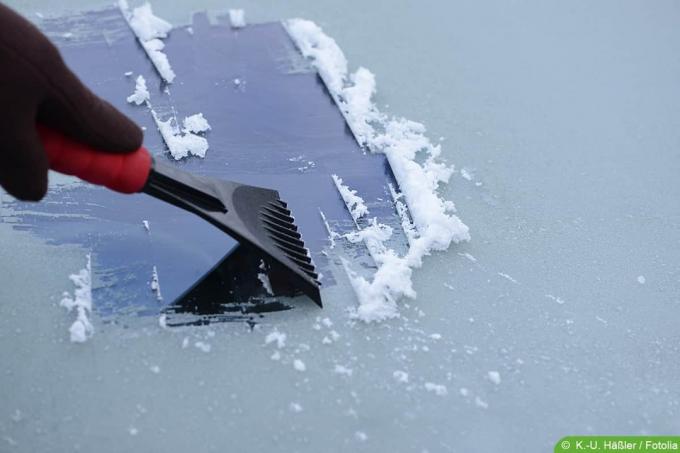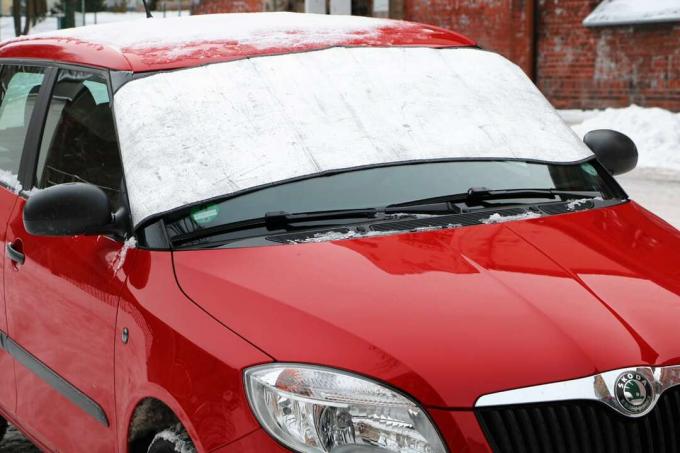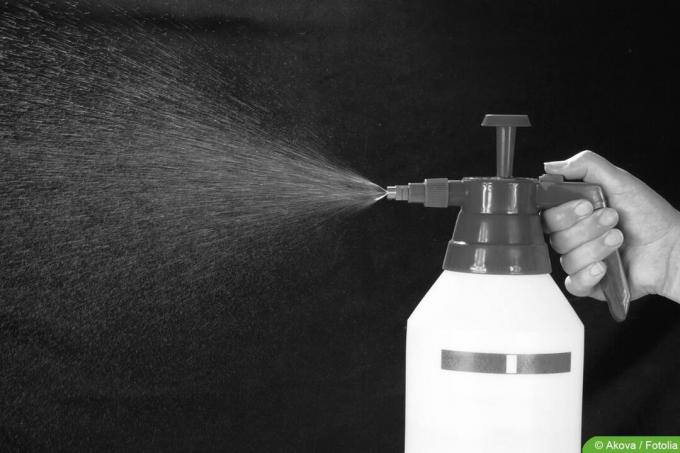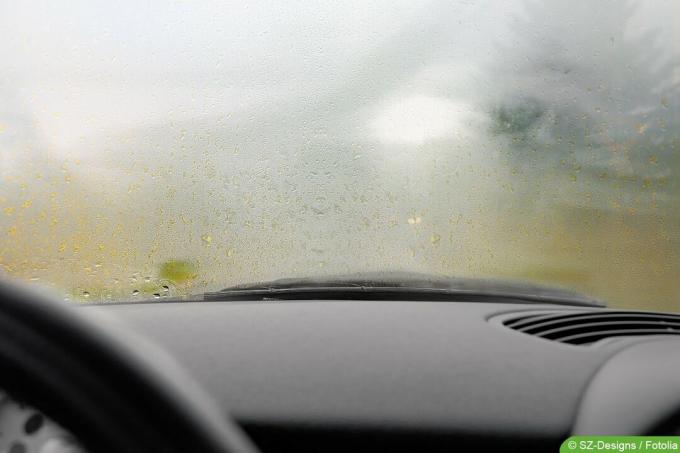

Table of contents
- Broom and hand brush
- ice scraper
- ice protection film
- deicer spray
- vinegar water
- hair dryer or hair dryer
- antifreeze
- Use semi-garage
- salt water
- Socks for the outside mirrors
- spirit
- Use auxiliary heating
- hot water bottle
If freezing rain and snow cover the car in winter, it must be de-iced. It is particularly important for the discs to be cleared of ice over a large area. Various methods are explained below to successfully de-ice a car.
Broom and hand brush
A broom or a hand brush should always be ready in the car in winter. Because with this, the first big snow or even the top thick layer of ice can be removed from freezing rain before removing the ice formed underneath and firmly adhering to the panes becomes:
- Always remove large amounts of snow or ice from the entire vehicle
- is required by law
- The roof, bonnet and trunk lid must be clean
- otherwise it may come off while driving
- can impede other road users
- in the worst case lead to accidents
ice scraper

If the vehicle has to be de-iced because the windows are frozen, then of course the first thing to mention is the ice scraper. This small device should not be missing in any vehicle in winter. Because freezing rain usually comes unprepared and there is no preparation for it. However, there are a few things to consider here:
- Always wear gloves when scraping ice
- prolonged scratching can lead to frostbite on the hands
- Don't use old CD cases
- Risk of scratches on the glass
- parking discs often have an ice-scraping side
- around all panes must be completely cleared of ice
- can be very exhausting with an ice scraper
- if possible, it is better to use other methods
However, the ice scraper, even one specially purchased for this purpose, should always be used with caution. Because if there are small dirt particles from previous trips on the iced windshield, it can quickly lead to scratches and thus cracks in the windshield. In the worst case, they even have to be replaced.
ice protection film

If cold, frost, snow or freezing rain have already been announced, then it is also a good idea to take precautionary measures. To do this, simply place an ice protection film on the windshield after parking the vehicle:
- can be purchased from specialist retailers or hardware stores
- alternatively, corrugated cardboard of the appropriate size will suffice
- Disc must be dry
- However, freezing wetness cannot be completely prevented
- only the windscreen is protected from ice
- remaining panes must still be de-iced
A notice:
Do not attempt to defrost the windshield or rear window with hot water. Even if the method seems sensible at first glance, the discs can jump. This often happens when there is already unnoticed minor damage on the pane, such as a small hole from a stone chip or a very thin crack.
deicer spray
Of course, the easiest method is to simply buy de-icing spray in stores and simply spray it on the windows and other icy spots on the vehicle before starting your journey. Nonetheless, this is a chemical bludgeon that can certainly be avoided. Especially when it's cold for a long time and the car is often icy, this method is of no use Less recommended for environmental protection reasons and especially when purchasing over weeks or even Months quite expensive:
- then clear the windshield with a windshield wiper
- work as quickly as possible
- just when the freezing rain keeps falling
- otherwise the cold car will quickly ice up again
vinegar water
Vinegar water is not intended for de-icing, but as a preventive measure to protect the windows from icing:
- Mix vinegar with water
- one to one
- put in spray bottle
- Spray windows in the evening before frost
- This prevents the formation of ice on the panes
- discs remain free
- if freezing rain falls all night, however, the method is useless
However, the vinegar water should not touch the paintwork of the vehicle, otherwise it might damage to the paintwork could occur, especially if more vinegar than water is filled into the bottle became.

A notice:
It is a legal requirement how far you have to de-ice your car. Just a small peephole in the windshield can result in a fine.
hair dryer or hair dryer
If the vehicle is parked near an electrical outlet, it makes sense to use an industrial hair dryer, or alternatively one to use a smaller hair dryer to free the windows of a thick, stubborn layer of ice, as is often the case with freezing rain occurs:
- don't use food
- put behind the windshield inside the car
- place it so that the entire pane receives warm air
- after about ten to fifteen minutes the ice can be loosened
- simply remove it from the outside with a broom or hand brush
- there is no scratching at all
The side effect of this method is that the interior is already slightly warmed up. As a result, the windows no longer mist up when driving off later, as is otherwise the case in a cold interior when warm breath hits the windows.
antifreeze
Antifreeze can be used to produce an effective and not so expensive, but unfortunately also chemical-based de-icer spray yourself. This is actually intended for the windshield wiper system so that the water does not freeze here in winter:
- available from specialist retailers or hardware stores
- cheaper to purchase than the ready-made de-icer spray
- mix with water
- in the ratio of two parts antifreeze to one part water
- fill in spray bottle
- spray iced windows with it
- then simply adjust the windshield wipers
Use semi-garage
The so-called semi-garages, which are placed over the vehicle and fastened with rubber ropes, are also a preventative measure. Not only in winter are these "throws" good methods against icing, in summer they also protect the paintwork and interior from strong sunlight:
- available from specialist retailers or hardware stores
- cover half the car
- so are the discs
- the vehicle is immediately ready to drive, even in freezing rain
- just remove the protection
These semi-garages may also be used when parking outside, for example in public parking lots or streets be used, since the license plates of the vehicles remain open and the car can therefore be checked at any time.
A notice:
Don't put old newspapers on the windshield in the evening before the dreaded freezing rain. Because these freeze solid and you then have to make even more effort to get the windows free again and, above all, clean.
salt water
Like vinegar water, salt water has a preventive effect. Here too, however, care must be taken to ensure that the salt does not come into contact with the paintwork of the car. If this is the case, the mixture should be washed off immediately. Because household salt also has a similar effect on the vehicle as road salt in winter and can damage the paintwork:
- a liter of warm water
- Stir in four to five tablespoons of salt
- dissolve well
- let cool down
- fill in spray bottle
- spray all windows in the evening before the frosty night

Socks for the outside mirrors
The exterior mirrors can also easily ice up. If these are not automatically heated when the engine is started, which is the case with many new cars is to thaw the ice by itself, these two mirrors usually also have to be de-iced manually become. But there is also a preventive solution here:
- pull long, soft socks over both mirrors
- prevents icing on frosty nights
- Socks and mirrors must be dry beforehand
- do not continue to use the wet socks from the previous day
Tip:
It's not just the windows around you that have to be cleared of ice and snow. The front and rear license plates must also be clearly visible at all times and must therefore not be forgotten.
spirit
Spiritus is alcohol which, when combined with water, can offer a good alternative to commercially available de-icing spray. Because the alcohol simply disappears in the air after use:
- Use rubbing alcohol or spirits from the drugstore
- mix one to one with water
- put in a spray bottle
- spray on the windows
- Ice is thus melted in a short time
- just wipe with the wipers
Use auxiliary heating
The parking heaters are a good way not only to clear the entire vehicle of ice and snow before starting a journey, but also to warm it up comfortably. These are either already installed in the new car models ex works. Retrofitting to a subsequently installed parking heater is also possible. But there are also parking heaters that can be easily placed in the car and run on battery power or in rechargeable battery mode:
- switch on some time before the planned journey
- most models come with a remote control
- retrofitting with permanent installation is often not cheap
- however, good comfort in cold climates
- there are cheaper mobile models
- are simply placed in the car in winter when required
- Ice and snow separates from the warm vehicle
- can be easily removed with a broom or hand brush
- Windows no longer fog up immediately when you start driving
When using parking heaters, the aspect of time must be taken into account. Ideally, these are switched on immediately after getting up in the morning, before breakfast, so that the vehicle is immediately ready for use later. If freezing rain falls unexpectedly during the day, then it also makes sense to switch on the heating about half an hour before the start of the journey.

A notice:
It is not a good idea to warm up the vehicle before driving during or after freezing rain. Here, too, a fine can be imposed, because this procedure, which used to be very common, is prohibited for reasons of environmental protection. And this "running while stationary" can also damage the engine.
hot water bottle
If there is enough time to free an iced vehicle, one or more hot water bottles can also be used. However, the effect of de-icing is rather small:
- Fill hot water bottles with hot water
- place on the dashboard
- a blanket or towel under the bottles to protect them from the heat
- the heat rises and frees the windshield from ice
- but usually only partially in the immediate vicinity
- However, it is suitable as an additional measure to other methods
- should be made some time before the planned trip
 Home editorial office
Home editorial office
Find out more about living in winter

Road salt: where is its use prohibited?
With winter comes the cold – and with it snow and ice, which owners and tenants have to clear from sidewalks. The use of road salt is prohibited in most municipalities and cities.

When does the conservatory count as living space?
Whether and to what extent the conservatory is part of the living space is important for the calculation of the living space. The area can have a significant impact on the rental price or the applicable property tax. The basis used for the calculation is important. Here you will find all information on the subject.

Is the triplet flower hardy? 10 tips for wintering
The enchanting bougainvillea got its botanical name after its discoverer, the navigator Louis de Bougainville. On the Mediterranean Sea, it embellishes house facades. In Germany, where it is also known as a triplet, it is particularly popular as a container plant. How is it overwintered?

Big holes in the garden: which animal was it?
Whether in the lawn or "just" in flower beds, holes in the ground make no gardener happy. But who causes the holes? And how do you get rid of them? We explain causes and strategies for annoying visitors underground.

Overwinter pampas grass | 16 tips for winterizing
Pampas grass is a popular ornamental plant in the garden or in tubs, which can be attractively integrated into a wide variety of garden ideas thanks to its decorative fronds. They are considered hardy, but need suitable winter protection in Central Europe due to possible moisture damage.

Overwintering strawberries: This is how they get through the winter
Lovers of the sweet, red fruits look forward to strawberry season every year. How good that strawberries appear perennial in the home garden. This guide reveals how strawberry plants survive the winter.
